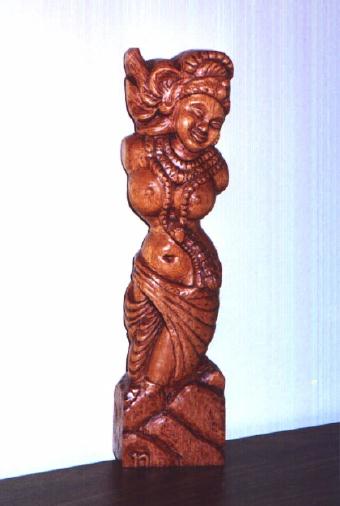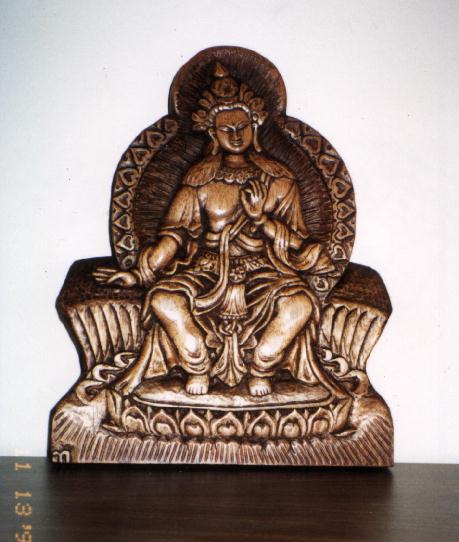We are pleased to welcome Nagaraj Shenoy to the pages of the E-zine. Dr. Shenoy is a relatively new carver, having started this past summer, and I think you'll agree he is doing quite well. He notes, "Carvings of Ivan Whillock were my greatest inspiration and I should thank him for that."
Dr. Shenoy is a computer scientist by profession, currently working as a research associate professor at Northwestern University in Evanston, IL.
-M. Kelley, Editor
As a visitor from India,
I had the opportunity to get to know of the works of several wood
carvers in this country - thanks to the web. Some of them really
inspired me into learning this beautiful art. In this article
I would like to share with you some of my creations that I attempted
using the wood locally available - western wood/tools, eastern
themes.
Indian sculptures are normally carved in black granite (one of the hardest stones) and the themes are almost always religious. Most of the temples I visited in India have intricately carved mythological figures either in relief or in-the-round. Some parts of India also have wooden sculptures, but probably less in number compared to the stone carvings. Teak wood and jack fruit (a tropical fruit) wood are the most popular woods used for carving. In Northern India you can also find carvings in Walnut wood (lighter in color than the American variety). Carving is a profession to most carvers in India rather than a hobby and often it is hereditary profession passed on over generations. These carvers learn the art from their parents when they are hardly teen-agers. The tools used are often very simple - no more than home made chisels. Yet the kind of details they carve is really amazing!
I started wood carving after I came to this country. Having grown up in a culture where art and religion are almost synonymous, the most natural thing for me to carve were religious symbols.
 My first carving was a
popular figure of Buddha, namely the Laughing Buddha
in American back walnut. Though the original "Laughing Buddha"
in China is in a sitting posture, there are several variations
of the same, as this one. It is also called Happy Man
and is often depicted as a comical character. My reverence to
Buddha made me carve it in a less comical way. I had a set of
Flexcut palm tools which I used to carve this figure. These tools
are good, but I found that walnut is a bit too hard to carve with
just palm tools.
My first carving was a
popular figure of Buddha, namely the Laughing Buddha
in American back walnut. Though the original "Laughing Buddha"
in China is in a sitting posture, there are several variations
of the same, as this one. It is also called Happy Man
and is often depicted as a comical character. My reverence to
Buddha made me carve it in a less comical way. I had a set of
Flexcut palm tools which I used to carve this figure. These tools
are good, but I found that walnut is a bit too hard to carve with
just palm tools.

After carving walnut,
I chose Honduras Mahogany for my next carving. I was amazed at
the excellent properties of this wood. I did not like the grain
though. But the wood is very easy to carve and finishes well.
This carving - titled Vrikshaka (wood nymph) is
based on a 7th century Indian sculpture described in a book on
Indian sculpture (5000 years of Indian Sculpture ... ).
Indians visualize god in every living and non living thing. This
specific form is a visualization of the divine in the trees (Vriksha
literally means tree) in the form of a nymph. As a result of several
invasions from outside, most of the sculptures in India (like
this one) are today in a highly mutilated state.
 Like
many of the ancient cultures, Indian mythology is full of
demigods which are not necessarily human like. You often find
human figures with animal heads (or vice versa). The one you see
here is the Garuda - half human half bird demigod.
As per the Hindu mythology, Garuda and Snake Gods are cousins
and due to rivalry between them, Garuda is often depicted as fighting
with Snakes. This particular one is a Tibetan version of the Garuda
which is slightly different from the traditional Indian form.
In the Indian sculptures, this demigod has almost a human like
body except for the wings and a long beak like nose.
Like
many of the ancient cultures, Indian mythology is full of
demigods which are not necessarily human like. You often find
human figures with animal heads (or vice versa). The one you see
here is the Garuda - half human half bird demigod.
As per the Hindu mythology, Garuda and Snake Gods are cousins
and due to rivalry between them, Garuda is often depicted as fighting
with Snakes. This particular one is a Tibetan version of the Garuda
which is slightly different from the traditional Indian form.
In the Indian sculptures, this demigod has almost a human like
body except for the wings and a long beak like nose.
 Like
the second coming of Jesus in the Christian
world, or the emergence of Kalki in the Hindu world, Buddhist
also believe that when 'the end' approaches, the Buddha would
reappear as Maithreya. The word literally means 'a friend'.
When I saw the original Tibetan line art of Maithreya
on the web, the first thought that came to my mind was 'can I
carve this in wood ?'. The original had too many intricate details
that I had to skip both because they made carving difficult and
time consuming and also because the peripheral details defocused
the main subject.
Like
the second coming of Jesus in the Christian
world, or the emergence of Kalki in the Hindu world, Buddhist
also believe that when 'the end' approaches, the Buddha would
reappear as Maithreya. The word literally means 'a friend'.
When I saw the original Tibetan line art of Maithreya
on the web, the first thought that came to my mind was 'can I
carve this in wood ?'. The original had too many intricate details
that I had to skip both because they made carving difficult and
time consuming and also because the peripheral details defocused
the main subject.
The raised hand is a well known gesture of 'Abhaya' which means
"fear not, I shall protect you". This personifies the
hopes of the people that their beloved would ultimately come to
their rescue. I don't know why unlike the traditional Buddha
images, this one looks more like a king than a monk.
 Let me conclude this article
with one more of my Buddha carvings. When I last visited
the Woodcraft store in Minnesota, a friendly salesman gifted
me a small piece of Butternut wood to try out. I am told that
Butternut is almost extinct in America and available only in some
states such as Minnesota. I had never carved this wood before.
I was perplexed by the dark grain patterns and too many worm holes
(the latter may be the cause of extinction) and did not know what
could be carved in such a wood with dominating characteristics.
Finally, I decided on this semi abstract theme, which seemed to
mesh well with the nice grains. I should say, it is an extremely
beautiful wood and competes well with Mahogany if only you can
find a subject that does not get threatened by the heavy grains.
Let me conclude this article
with one more of my Buddha carvings. When I last visited
the Woodcraft store in Minnesota, a friendly salesman gifted
me a small piece of Butternut wood to try out. I am told that
Butternut is almost extinct in America and available only in some
states such as Minnesota. I had never carved this wood before.
I was perplexed by the dark grain patterns and too many worm holes
(the latter may be the cause of extinction) and did not know what
could be carved in such a wood with dominating characteristics.
Finally, I decided on this semi abstract theme, which seemed to
mesh well with the nice grains. I should say, it is an extremely
beautiful wood and competes well with Mahogany if only you can
find a subject that does not get threatened by the heavy grains.
Here, the Buddha is shown as sleeping peacefully by resting one of his feet on the head of an angry lion. The lion is supposed to symbolize various temptations and Buddhahood is all about being un-perturbed by them and remaining in inner peace.
You may email Nagaraj Shenoy at nagarajshenoy@hotmail.com